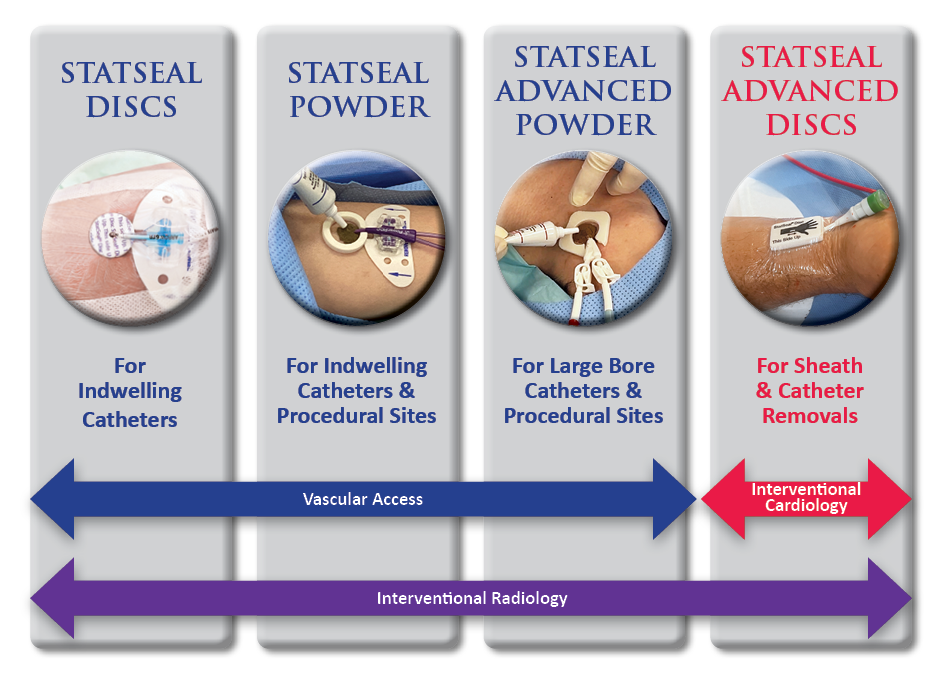THE SEAL IS THE DIFFERENCE
StatSeal products help standardize, simplify and minimize post procedure care and maintenance of:
Sheath & Catheter Removals • Vascular Access Sites • Procedures with External Bleeding
StatSeal topical hemostatic products instantly create an occlusive seal over procedural sites to stop the flow of blood and exudate. StatSeal products are especially useful for patients prone to bleeding because they work independently from the clotting cascade to seal the procedural site, while accelerating hemostasis, regardless of anticoagulation levels.
StatSeal products form an occlusive seal that stops bleeding and oozing, and continues to strengthen over time and with manual pressure. StatSeal products are available in both powder and disc (compressed powder) form to suit a wide variety of clinical applications.

HOW DO STATSEAL PRODUCTS WORK?
StatSeal products are comprised of a hydrophilic polymer and potassium ferrate. As a manual pressure adjunct, StatSeal products have a two-step mechanism of action that occurs simultaneously to instantly form a low pH occlusive seal or physical barrier over the wound site, letting nothing in or out.
The hydrophilic polymer rapidly dehydrates the blood and absorbs exudate, stacking up desiccated blood solids beneath to form a seal. The potassium ferrate binds the blood solids and proteins together, adhering the seal to the wound to stop bleeding and oozing.
Beneath the seal, the pH is neutral and blood solids and proteins continue to stack naturally. Above the seal the hydrophilic polymer acts as a desiccant and creates an acidic environment with a pH of ~ 2.
STATSEAL CLINICAL DATA
A recently published study in the British Journal of Nursing demonstrates StatSeal efficacy for managing PICC exit site bleeding and improving patient outcomes. The article, authored by Angela Hastings and Andrew Barton is titled: “Rapid haemostasis to achieve dressing longevity: evaluation trial results using StatSeal catheter exit site protection.”
The purpose of the trial “was to evaluate the efficacy and safety of StatSeal for haemostasis following PICC line insertion. The trial was conducted on adult inpatients requiring a PICC or outpatients requiring a PICC for chemotherapy or home IV antibiotics.” The primary endpoint was dressings that lasted 7 days. Of the StatSeal dressings, 99% lasted 7 days, whereas only 7% of the dressings without StatSeal lasted 7 days.
The article also included a cost analysis indicating that StatSeal use provided a cost savings of at least £21.43 ($27.66 USD) per catheter. From the authors’ experience, many catheters without StatSeal are likely to require multiple unplanned dressing changes. The conclusion indicated “Using StatSeal improved patient outcomes and reduced the number of dressing changes required in a 7-day period, saving time and money. StatSeal is a reliable, valuable product for the management and control of vascular access catheter exit site bleeding.”
COVID-19 PATIENTS
Patients hospitalized with COVID-19 are more susceptible to developing clots. This has led to the use of powerful anticoagulants in COVID-19 patients and consequential bleeding issues. StatSeal products work independently of the clotting cascade to achieve rapid and reliable hemostasis, even for highly anticoagulated patients. A recent video of a COVID-19 positive patient demonstrates how StatSeal Advanced Powder helped achieve rapid hemostasis despite two extreme factors: a 13.5 French line and an elevated International Normalized Ratio (INR) of 3. The extremity of this situation illustrates the remarkable ability of StatSeal products to achieve hemostasis on all patient types.
The results of several recent studies demonstrate the ability of StatSeal products to help reduce dressing changes and achieve cost savings, independent of the ongoing COVID-19 pandemic (Ayala, et al., Olsen, et al.).


